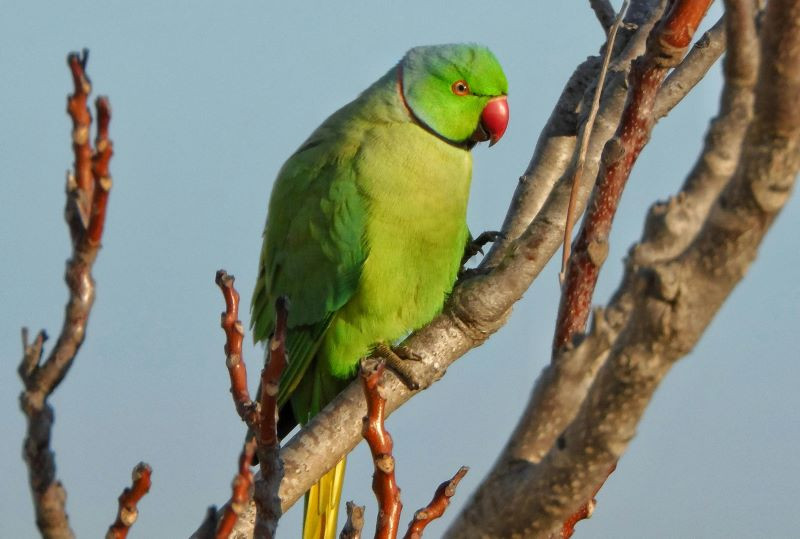
Pakistan is in danger of losing one of its famed birds, the Alexandrine parrot, which is already on a global list of near-endangered species due to multiple factors, most of them human-made.
Habitat alteration, pollution, poaching and illegal trade are being listed as major factors behind the decline in the bird’s population, which is still the largest among the three parrot species found in Pakistan.
Once abundant in the country’s plains, mainly along canals and foothills, and even in Karachi, its population is currently restricted to the upper parts of Punjab and Sindh and the border areas of Pakistan and India, including Jammu and Kashmir.
The tree-filled foothills of the scenic Murree Hill Station are another home to Alexandrine parrots.
Apart from the systematic destruction of their habitat, they have become a source of income for a sizable number of people across Pakistan, resulting in increasing poaching and subsequently illegal trade. The Indian rosewood (Shisham or Tali) and Banyan (Ficus benghalensis) trees, are the parrots’ favorite nesting place, which are being cut down in the agriculture belt of Punjab and Sindh because of their precious wood.
The agriculture authorities have replaced Indian rosewood with eucalyptus, which is useless for parrots and other human-friendly birds.Eucalyptus in Pakistan was exported from Australia to feed the matchstick industry and according to some environmentalists, it is environmentally hazardous.
The use of agrochemicals, increasing human influence and pollution are other key factors behind the decline in the parrots’ population. In Karachi alone, the parrots’ numbers have plummeted by 60 percent over the past five to eight years.
The alteration of habitats, a direct result of unplanned urbanization and pollution, has badly affected the population of urban birds in major cities, mainly house sparrows and parrots.
Instead of human-friendly birds such as sparrows and parrots, which also serve as indicators of air quality, bird species such as kites, crows and mynas have occupied the skies of these cities.
Predatory birds, mainly kites, often target parrots and sparrows, adding to the decline in the population of human-friendly birds.
Recently, a survey was conducted in Islamabad, and surprisingly, no Alexandrine parrots were spotted in the capital’s skies, indicating the gravity of the threats facing the bird. If the situation persists, these birds may hardly be seen in Islamabad.
The Alexandrine parrot is the largest parrot species found in the country. They have red patches on their wings and are green in color, with mutations also occurring.
According to Anis Rehman, a wildlife expert based in Islamabad, the Alexandrine parakeet (Psittacula eupatria) is named after Alexander the Great, who is said to have first sent several of the birds from Punjab to the West, where they became popular as exotic pets of rich and noble families.
In addition to its large size, this species has the ability to mimic human speech, which makes it one of the most wanted birds by pet lovers, he added. A chick can earn a poacher Rs10,000-Rs12,000, while an adult Alexandrine parrot is sold for up to Rs50,000 in pet markets, according to Rehman.
“If a poacher catches a group of five to 10 hatchlings and parrots in a month, he can easily earn between Rs100,000 and Rs150,000, which is almost four times higher than the minimum [monthly] salary of Rs37,000,” he said.
Aside from pet lovers, professional breeders also buy wild parrots to crossbreed them with their bred species to improve the latter’s immunity.
The parrots play an important role in seed dispersal, while their nests serve as hibernation sites for several animals, mainly snakes and some squirrel species in the winter.
Many parrot species are in decline, and several are extinct. Of the 350 living species, some 130 are listed as near threatened or worse by the International Union for Conservation of Nature.
The bird’s population in Pakistan has not been estimated.
The IWWB has registered over 50 breeders and 178 individuals (pet lovers) keeping over 2,200 parrots to ensure they cannot sell these birds into the market. Even their hatchlings will be registered.
1715630343-0/image-(2)1715630343-0.jpg)
Once Pakistan’s trees and natural habitat were home to rare birds, including parrots, but an indiscriminate cutting of trees has led to the destruction of habitats of birds.
Recently, the government decided to color parrots and their babies in the Punjab and Islamabad to adopt a wild lifestyle again. Officials will launch an awareness campaign by visiting villages and educational institutions.
Kasur district is the habitat of wild green parrots from where the parrots visit the public parks of Lahore after a change in season. The rare breed of wild parrots is dying due to theft.
A resolution has recently been passed to impose hefty fines on both the poachers and traders of green parrots as parrots are also stolen from different parks and cemeteries of Islamabad.
There has been a solution to improve and protect the breed of domestic wild parrots by adopting the crossbreeding formula of Thailand, Vietnam, Malaysia, Singapore and Japan. The crossbreeding of parrots from these countries will help change the colors of domestic parrots. Modern branding centers can be set up in Karachi, Lahore, Rawalpindi, Islamabad, Gujranwala and Peshawar so that newly-produced parrots could be brought to public parks, resorts, and cemeteries.
